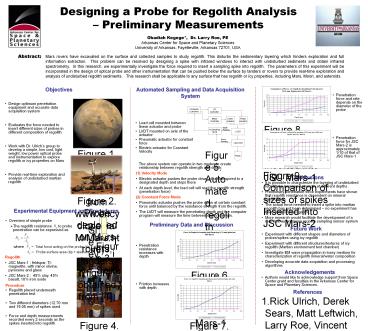Mars rovers have excavated on the surface and collecte - PowerPoint PPT Presentation
1 / 1
Title:
Mars rovers have excavated on the surface and collecte
Description:
Mars rovers have excavated on the surface and collected samples to study regolith. ... JSC Mars-1 : feldspar, Ti-magnetite, with minor olivine, pyroxene and glass ... – PowerPoint PPT presentation
Number of Views:74
Avg rating:3.0/5.0
Title: Mars rovers have excavated on the surface and collecte
1
Designing a Probe for Regolith Analysis
Preliminary Measurements
Obadiah Kegege, Dr. Larry Roe, PE Arkansas
Center for Space and Planetary SciencesUniversity
of Arkansas, Fayetteville, Arkansas 72701, USA
Abstract
Mars rovers have excavated on the surface and
collected samples to study regolith. This
disturbs the sedimentary layering which hinders
exploration and full information extraction.
This problem can be resolved by designing a spike
with infrared windows to interact with
undisturbed sediments and obtain infrared
spectrometry. In this research, we
experimentally investigate the force required to
insert a sampling spike into regolith. The
parameters of this experiment will be
incorporated in the design of optical probe and
other instrumentation that can be pushed below
the surface by landers or rovers to provide
real-time exploration and analysis of undisturbed
regolith sediments. This research shall be
applicable to any surface that has regolith or
icy properties, including Mars, Moon, and
asteroids.
Objectives
Automated Sampling and Data Acquisition System
- Penetration force and rate depends on the
diameter of the probe
- Design optimum penetration equipment and accurate
data acquisition system - Evaluates the force needed to insert different
sizes of probes in different composition of
regolith - Work with Dr. Ulrichs group to develop a simple,
low cost, light weight, low power optical probe
and instrumentation to explore regolith or icy
properties on Mars - Provide real-time exploration and analysis of
undisturbed martian regolith
- Load cell mounted between linear actuator and
probe - LVDT mounted on axle of the actuator
- Pneumatic actuator for constant force
- Electric actuator for Constant Velocity
Figure 8. Comparison of sizes of spikes Inserted
into JSC Mars-1
- Penetration force for JSC Mars-2 is approximately
1/10 of that of JSC Mars-1
Figure 1. Mars (figure obtained from
www.encyclopedia/M/Mars.html)
Figure 5. Automated regolith Sampler
- The above system can operate in two modes to
create relationship between regolith strength and
depth - (1) Velocity Mode
- Electric actuator pushes the probe down at
certain speed to a designated depth and stops
there - At each depth level, the load cell will read the
regolith strength (penetration force) - (2) Constant Force Mode
- Pneumatic actuator pushes the probe down at
certain constant force until balanced by the
resistance strength from the regolith. - The LVDT will measure the penetrating depth and
the computer program will measure the time
between depth intervals.
Figure 9. Comparison of sizes of spikes Inserted
into JSC Mars-2
Conclusions
- It is possible to characterize the layering of
undisturbed regolith by measured strength at
different depths - Preliminary penetration force experiments have
shown that regolith resistance is dependent on
mineral composition - The actual force needed to insert a spike into
martian regolith has not been determined no
experiment has been done on icy regolith - More research would facilitate the development of
a real-time autonomous regolith sampling sensor
system
Figure 2. Probe deployed on Mars rovers, landers
(figure obtained from 1)
Experimental Equipment and Procedures
- Overview of simple probe
- The regolith resistance to probe penetration
can be expressed as
Preliminary Data and Discussion
Future Work
- Experiment with different shapes and diameters of
probes/spikes using icy regolith - Experiment with different structures/textures of
icy regolith (Martian environment test chamber) - Investigate EM wave propagation in lossy medium
for characterization of regolith mineral/water
composition - Developing accurate data acquisition and
processing algorithms
Figure 3. Spike
- Penetration resistance increases with depth
- Friction increases with depth
Total force acting on the probe (tip sleeve)
- where
Probe surface area (tip sleeve )
- Regolith
- JSC Mars-1 feldspar, Ti-magnetite, with minor
olivine, pyroxene and glass - JSC Mars-2 45 clay, 45 basalt, 10 iron
oxide
Acknowledgements
Figure 6. Inserting 12.70 mm spike into JSC Mars-1
- Authors would like to acknowledge support from
Space Center grant and faculties in the Arkansas
Center for Space and Planetary Sciences.
- Procedure
- Regolith placed underneath penetration test
- Two different diameters (12.70 mm and 19.05 mm)
of spikes used - Force and depth measurements recorded every 2
seconds as the spikes inserted into regolith
References
- Rick Ulrich, Derek Sears, Matt Leftwich, Larry
Roe, Vincent Chevrier, Walter Graupner, Fiber
Optic Spectral Array on a Regolith Probe for
Surface and Sub-Surface Mineralogical Profiling
Optical Probe for Regolith Analysis, Arkansas
Center for Space Planetary Sciences, University
of Arkansas, June 2006 - Peter M. Cao, Ernest L. Hall, Soil sampling
sensor system on a mobile robot - Proceedings of SPIE, Intelligent Robots and
Computer Vision XXI Algorithms, Techniques, and
Active Vision, pp. 304-310, October 2003 - Jeffrey E. Herrick, Tim L. Jones, "A dynamic
cone penetrometer for measuring soil penetration
resistance", Soil Science Society of America
Journal 661320-1324 , 2002 - Bradley D.A, Seward D.W., Developing real-time
autonomous excavation-the LUCIE story,
Proceedings of the 34th IEEE Conference on
Decision and Control, 1995.
Figure 4. Mechanical penetration test stand with
four linear electric actuators
Figure 7. Inserting 19.05 mm spike into JSC Mars-1































